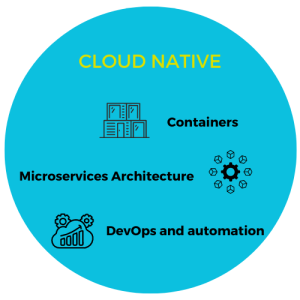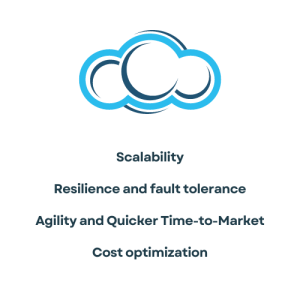WHAT IS CLOUD NATIVE?
Cloud-native development has developed as a paradigm that enables enormous scalability, flexibility, and resilience for contemporary applications in the constantly changing world of software development. By outlining its concepts, advantages, and recommended practises, cloud-native development will be made less mysterious in this blog article. This guide will give you insightful information on creating applications that thrive in cloud environments, regardless of your level of experience as a developer or where you are in your cloud journey.
Understanding Cloud Native
A method known as “cloud-native development” involves creating apps expressly for cloud platforms by utilizing its natural features. It incorporates cutting-edge techniques like automated deployment, microservices design, and containerization, empowering programmers to create scalable, robust, and loosely linked systems.
Key Principles of Cloud-Native Development:

- Containers: Cloud-native development is mostly dependent on containerization technology like Docker. It enables the packaging and isolation of applications along with their dependencies, ensuring consistent deployment across various environments.
- Microservices Architecture: Microservices, sometimes referred to as small, independent, and loosely connected services, are a common component of cloud-native systems. This architecture encourages fault separation, scalability, and simpler maintenance.
- DevOps and automation: Continuous integration/continuous delivery (CI/CD) pipelines and integration of development and operations teams are key components of cloud-native development. Application upgrades and deployment are made possible by automation.
Benefits of Cloud-Native Development:

- Scalability: Cloud-native applications can scale easily to meet changing demands by utilising the flexibility of the cloud, resulting in optimal performance and cost effectiveness.
- Resilience and fault tolerance: Cloud-native applications can resist failures through the use of distributed systems and fault-tolerant design, enabling high availability and decreased downtime.
- Agility and Quicker Time-to-Market: By enabling quick application creation, deployment, and upgrades, cloud-native development shortens time-to-market and gives businesses a competitive edge.
- Cost optimization: By allowing applications to scale only when necessary, cloud-native architectures optimize resource utilization and reduce costs by avoiding over-provisioning.
What does it mean for a technology to be cloud native?
When a technology is referred to as “cloud-native,” it signifies that it was created and optimized with the intent of maximizing the benefits and capabilities of cloud computing environments. Because of the scalability, flexibility, and resilience of cloud platforms, cloud-native solutions are designed to run and function well on them.
Here are some essential attributes and things to think about while using cloud-native technologies:
- Containerization: To bundle applications and their dependencies into portable and isolated pieces, cloud-native technologies frequently make use of containerization technology, such as Docker. Applications can now be deployed consistently across several cloud environments, increasing their scalability and management ease.
- Microservices Architecture: A microservices architecture is often used in the development of cloud-native applications. Using this strategy, complicated applications are divided into smaller, independent services that may be created, implemented, and scaled independently. Greater flexibility, scalability, and fault separation are made possible by microservices, which also facilitate continuous integration and delivery.
- DevOps and Automation: The DevOps philosophy is embraced by cloud-native development, placing a strong emphasis on collaboration and automation between the development and operations teams. A shorter time to market and increased agility are made possible by continuous integration/continuous delivery (CI/CD) pipelines that automate application deployment, testing, and upgrades.
A revolutionary method for creating applications that can fully utilize the cloud is cloud-native development. Developers may design scalable, resilient, and agile applications that change with the demands of the business by embracing containerization, microservices, and automation. For businesses looking to remain competitive in the digital age, mastering cloud-native development practices will be essential as cloud technologies improve.

